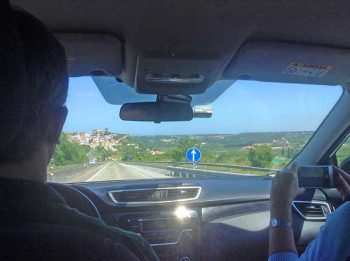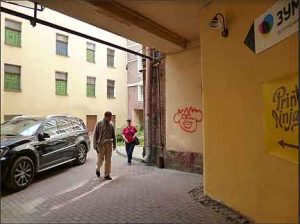
Keyless car theft is possible even when a car is locked and the electronic fob is away from the car. With a small electronic gadget, thieves can open the car and steal its contents, start the car, and drive it off.
Eve D. wrote to tell me about the recent theft she experienced while traveling by car through Portugal. Eve is well aware of theft risks, and her husband, Jeff, goes so far as to Velcro his wallet. I presume by that Eve means that Jeff keeps his wallet in a pocket with a Velcro closure.
Eve wrote:

We drove from Lisbon to the tiny walled town of Obidos, Portugal.
There, just outside the city wall, our rental car was broken into and all our carry ons, with all our valuables, were stolen. Our car was an SUV so you could see that we had luggage in the car, but the car was definitely locked when we left it.
The thieves just took the carry ons, leaving the big, more obvious suitcases. They used a remote control thing that can open cars with keyless entry.
Keyless car theft
Keyless car theft is a growing crime and a threat to all (it seems) cars with touchless wireless key fobs. Wireless-entry fobs work by proximity; the doors won’t open and the car won’t start unless the fob is quite close to the car. The signals sent between the car and fob are weak, so the two must be close to one another in order to work. At least, that’s how it’s supposed to work.
When you’re at home, where’s your car? In the driveway? On the street? And where’s your electronic key (and your spare electronic key)? In the house somewhere, right?, and too far from the car to work.
Car thieves are using an electronic signal booster, or amplifier, to make the car and distant key communicate with each other over a longer distance. When it works, the thieves can unlock the car, start it, and drive away.

In Eve’s case, it’s not clear that her key and car were close enough together, since she describes her car as being parked outside the ancient (thick) city wall. However, a thief with a signal amplifier, good timing, and a lot of nerve would be able to accomplish the boost and get the car unlocked before the fob walks too far away. That is, beyond several hundred meters. Especially if he doesn’t intend to start the car.
We were moving from one town to another and decided to stop at Obidos to have lunch. We were not parked in a secluded spot; there were probably about 15 cars in the lot with us. There were workman inside the walls setting up for a medieval fair. Some of the cars were probably the workers’ so maybe there wasn’t much in-and-out activity. I tend to think the workers could have been involved.
I would guess not. The workers are gainfully employed (in a country with 11-12% unemployment), they were busy working, and they wouldn’t likely risk their jobs.
Keyless-entry car theft
We did file a police report. Thank goodness one in our group was a Brazilian who spoke Portuguese, but I don’t think filing the police report did much good. The police said they would keep a lookout for our things along the road. Obidos is a very safe city, somewhat off the beaten track. But the police said ours was the second incident reported that day.
Sounds like a booster-booster in the neighborhood. (Do I need to point out that booster is slang for thief?)
The rental cars in Europe have stickers on their windshields announcing the fact that the car belongs to tourists. So, please remind tourists not to leave anything in their cars.
Excellent advice, when possible. But how should Eve have behaved differently? It was a calculated risk, a short stop, a quiet town, a happy mood, and everything should have been okay. You have to live, right?
I’m sure that I wouldn’t have taken that chance though. I’d choose a restaurant where I could park my car in full view from a window or patio, or I’d get something to go, or leave a volunteer to stay with the car. But I’m in the steal business and more aware of the risks. I’m not much of a chance-taker. (I lived in Vegas for 20 years and never gambled.)
I think the clicker thing, remote door opener, has been around for a while. We had our whole car taken in Marseille about 10 years ago.
Eve is right. These keyless-entry signal-amplifiers have been around for some time, though they haven’t been seen much by law enforcement. Just this week, European security researchers announced that most cars built by Volkswagen since 1995 can be broken into with a wireless hack. “Our findings affect millions of vehicles worldwide and could explain unsolved insurance cases of theft from allegedly locked vehicles,” the researchers wrote. Millions of vehicles! (Eve’s rental was a Nissan.)
Earlier this month, two men were arrested for keyless car theft, suspected of stealing more than 100 cars and moving them across the border to Mexico. Rather than a signal amplifier, these men used a laptop and software intended for use by dealers and locksmiths. It’s yet another way that keyless-entry systems can be bypassed. A safety-hatch for us car-owners, it’s also a backdoor ready to be exploited by any evil-doers so motivated.
So, why did Eve’s thieves take the carry-ons and leave the large luggage? Maybe they got away on a motorcycle or in a tiny smart car. Maybe they ran out of time. Or maybe they wanted the jewelry and electronics more likely to be found in carry-on bags, and didn’t need the socks and sweaters that would be in suitcases.
So just a reminder…the rental cars in Europe have stickers on the windshield. Do not leave anything in the car, and maybe not get an SUV. Our car was parked in a small lot so maybe not public enough. Also there was a curve in the road so that someone could be looking out. There were work trucks there too.
Try a faraday cage
What else can we do to protect our cars and their contents? You can keep your fob (and spare) in a faraday cage to prevent it from transmitting radio signals. A faraday cage could be your refrigerator or some other metal box. (A refrigerator might not be good for the key fob’s battery.) Or it could be a pouch or wallet made of metal mesh especially for this purpose—many are available.
If you park in a high-crime area or you drive a highly-desirable car (to a thief), and your keyless-entry fob is typically within 100 meters or so of the parked car, it might be a good idea, unless you can secure the car in a locked area. For the rest of us, it might be a step too far. And it certainly cancels the convenience of a wireless fob.
Of course the manufacturers should fix this vulnerability—though they’ve known about it for five or more years already and haven’t. In the meantime, we drivers will lose more cars and more personal items left inside our cars, and find little or no trace of the thieves.
EDIT 8/20/16: In a reverse problem, you might be locked out of your car when your key fob is affected by interference from a neon sign or locked out of your garage due to interference from LED lights in the garage.
EDIT 11/28/17: Watch video of two white-jump-suited thieves steal a Mercedes using a signal amplifier. Takes 19 seconds to get the car door open.







No comment yet, add your voice below!